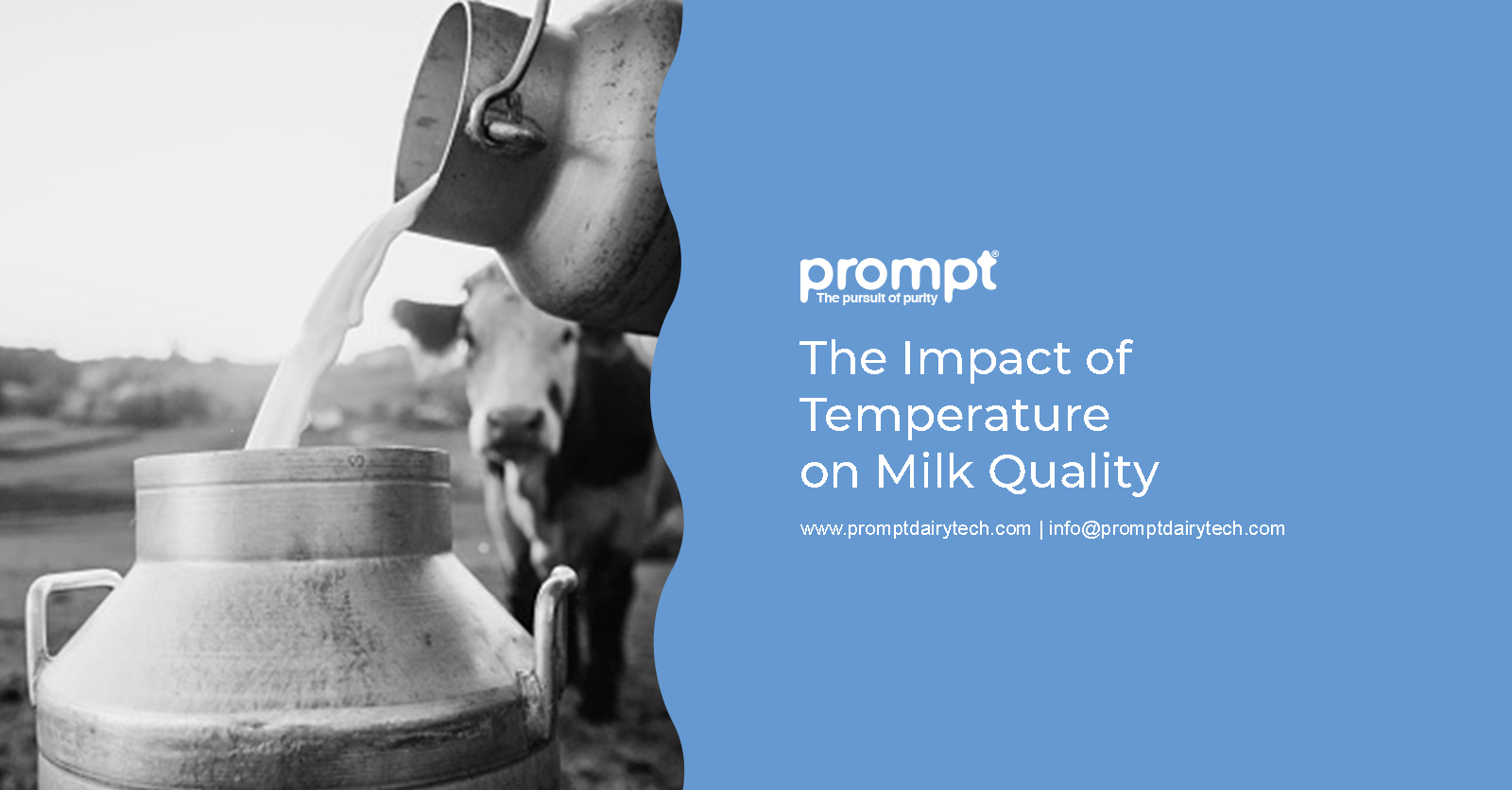The Impact of Temperature on Milk Quality: Challenges Faced During Summer


Milk quality is a crucial factor in manufacturing dairy products like ice cream, UHT milk, yoghurt, cheese, etc., and temperature plays a paramount role in maintaining this quality. A significant rise and dip in temperature can alter the percentage and chemical structure of fats, lactose, proteins, and non-fat solids, affecting milk quality and composition.
In this context, dairy firms face challenges maintaining milk quality as the mercury rises in summer. The composition alters, increasing the risk of spoilage.
However, there are ways to eliminate the impact of increasing temperature and provide even conditions for milk quality preservation. Let us explore the solutions by first explaining the relationship between milk quality and temperature.
Understanding the Relationship between Temperature and Milk Quality
As mentioned, temperature plays a crucial role in preserving milk’s nutritional integrity and safety. Temperature variation during transporting and storing milk, especially during summer, can significantly impact its properties. Let us find out how.
Effects of temperature fluctuation on milk quality
Higher temperatures can lead to protein denaturation and separation of fat. It has been found that an increase in temperature decreases the protein, fat, and non-fat solid content of milk. On the other hand, lowering temperature inhibits bacterial growth but commences undesirable changes in texture and flavour.
Hence, to preserve milk’s nutritional and sensory characteristics, an optimal temperature should be maintained while handling and storing it in dairy firms.
Temperature control for preserving milk freshness
Proper refrigeration techniques aligning with the latest technologies should be adopted during storage and transportation. For instance, using an instant milk chiller omits temperature fluctuation and maintains the freshness and quality of milk. It enables firms and storage units to inhibit microbial growth and increase the shelf life of stored milk.
After pasteurizing milk to eliminate harmful pathogens, chilling milk instantly within an optimum temperature range is a proven quality preservation process. Also, temperature monitoring and management systems for dairy industries can uphold quality and safety along with consumer satisfaction.
Challenges faced in maintaining Milk Quality during Summer
The dairy industry faces many challenges in maintaining milk freshness and quality as the temperature rises in the summer months. The following challenges deteriorate milk safety.
Increased bacterial growth
The elevated temperature and humidity during summer months create a favourable condition for increased bacterial growth in stored milk. Such rapid growth leads to contamination and spoilage, resulting in huge losses for dairy firms. Besides sanitation practices, a milk chiller offers a storage environment with no temperature fluctuation to control bacterial growth.
Risk of spoilage
The microbial activity and enzymatic changes in stored milk are directly proportional to the increase in temperature. Hence, the risk of spoilage increases with the time milk is exposed to summer temperature. The accelerated enzymatic change alters the texture, flavour, and odour of milk and makes it unfit for dairy product manufacturing and consumption.
Reduced shelf life
Summer conditions reduce the shelf life of stored milk due to the challenges mentioned above. Dairy firms and product manufacturers face this challenge mostly in elevated temperature conditions. Stored milk loses its qualitative features rapidly. In fact, dairy products manufactured from stored milk do not generate customer satisfaction. Managing inventory in such conditions demands for enhanced preservation methods with proper temperature control.
Impact on dairy cow health and milk production
Livestock goes through environmental stress during the summer months. The hot and humid conditions result in a low yield of milk in terms of quality and quantity. This factor has a domino effect on livestock futures, income, and food security.
Reports show that high temperature reduces feed intake and decreases milk production. Heat stress increases the average body temperature of dairy cows resulting in low-quality milk production resulting in economic loss. Dairy farmers must implement measures to omit heat stress by providing shade and adequate ventilation in the cowpens for optimal milk production.
Factors Contributing to Temperature-Related Challenges
Certain external factors also contribute to these temperature-related challenges in maintaining dairy milk quality.
Ambient temperature fluctuations
Ambient temperature fluctuations during summer months pose significant challenges to preserving milk quality. This variation directly impacts milk storage environments, causing bacterial growth. This results in reduced shelf life and milk spoilage. On the other hand, sudden temperature changes trigger condensation and microbial contamination in milk.
Inadequate cooling and storage facilities
Inadequate cooling and storage facilities in dairy industries are a major hurdle in milk quality preservation. Old-model milk chillers are unable to control temperature and humidity fluctuations due to improper insulations. Ventilation issues inside the storage units also contribute to this problem. A modern milk chiller for dairy farms omits all such issues, providing better temperature control.
Transportation and handling issues
Apart from storage, handling and transportation issues play a major role in milk spoilage during summer. Improper handling in the supply chain exposes milk to fluctuating temperature conditions, and prolonged transit times with improper temperature-controlling units cause more spoilage.
How Does Temperature Affect Milk Components?
Learning the effect of temperature fluctuations on milk components will assist in creating more effective storage environments. Here is how it affects the following milk components.
Fat content
The stability of fat globules in milk is compromised when temperature is increased or decreased. When fat globules are exposed to a temperature higher than the ambient one, they destabilize. Their viscosity reduces, causing them to rise above and accumulate on the surface. This phenomenon is called creaming. On the other hand, lower temperatures can slow down the movement of fat globules, making them disperse evenly into milk.
Protein integrity
In the same context, protein in milk gets structurally altered when exposed to summer temperatures. This structural change causes denatured proteins and milk to lose texture, viscosity, and foaming properties. Low temperature can reduce this phenomenon where proteins remain in a stabilized condition. They don’t degrade, and the milk’s quality is preserved for a longer period.
Bacterial count
Bacterial growth is significantly influenced by temperature fluctuations. As discussed, an increase in storage temperature results in rapid bacterial growth, causing contamination. Eventually, the consistency of milk is compromised. Low-temperature storage conditions preserve milk better by reducing bacterial growth considerably.
Flavour and aroma
Temperature is a crucial factor that controls the rate of natural enzymatic reactions in milk. At higher temperatures, the rate of enzymatic breakdown of protein and fat content is higher. It also increases microbial content in milk. Hence, milk’s exposure to higher temperatures compromises its flavour and aroma.
Strategies for Mitigating Temperature-Related Challenges
Proper cooling and storage practices
Milk quality and safety are the prime concerns for dairy industries. Effective strategies to stop temperature fluctuations in summer will assist in achieving our prime goals. Handling and storing milk has a transition period from bigger to smaller storage units. The associated environment should have proper temperature-controlling measures.
Adopting the Latest Milk Chilling technology
The advanced instant milk chilling technology is what every dairy industry needs to incorporate. This technology chills stored milk within the preferred temperature range to stop microbial growth and arrest component degradation.
For instance, MilkoChill, a high-quality milk chiller for dairy farms, maintains an ambient temperature of up to – 4°C. It can chill up to 250 litres of milk within this temperature range in an hour.
Ventilation and insulation in dairy facilities
Proper ventilation and insulation in dairy facilities will maintain a consistent temperature. So, heat does not build up inside a storage facility. Constant heat dissipation and humidity control provide a comfortable environment for milk storage and livestock. Apart from controlling stored milk temperature, the external heat and moisture level should be controlled, too.
Milk transportation management
Transporting milk from the farmer’s doorstep to the dairy storage facilities takes a lot of time. The door-to-door collection needs proper infrastructure to preserve milk quality. Using a milk chiller can be very effective. It can reduce the temperature of stored milk to the preferred gradient within an hour. The milk chiller 500 ltr price and energy consumed for chilling milk will be less than the loss incurred due to spoiled milk in summer.
Success Story:
Asha Mahila Milk Producers Ltd Achieved Landmark Chilling Capacity and Improved Farmer Income with Prompt Group’s Instant Milk Chiller
Asha Mahila Milk Producers, in collaboration with the World Wide Fund (WWF) and Prompt Group, inaugurated a groundbreaking project called “Instant Milk Chilling” in August last year. The project’s core objective was to introduce affordable milk chilling at small collection centres immediately after milking. MilkoChill, developed by Prompt Group, has effectively met this objective.
Each unit of the solar-powered milk chillers has a 3.35 kWh battery that can chill 500 litres of milk per day. The instant chilling of the milk has significantly improved the shelf life of milk produced by Asha Mahila Milk Producers, thereby reducing the overall spoilage and increasing the income of the farmers.
MilkoChill is built on a patented thermodynamic system that ensures effective chilling even in the absence of electricity.
WWF India, in collaboration with HSBC, has installed 38 such units across Uttar Pradesh and Rajasthan. The total 175-KW capacity can process 26,000 litres of milk per day.
Overcome the Temperature Challenges of Summer with Perfect Milk Chillers
Controlling temperature plays a crucial role in preserving milk quality. Right from the collection source to storage, maintaining an ambient temperature is mandatory for milk quality preservation.
Overcome the temperature challenges during summer to preserve milk quality by using Prompt’s milk chillers. Our MilkoChill 160 L and 250 L units are capable of chilling milk at full capacity within an hour. Compare the milk chiller price with collection and distribution needs. Embrace the latest milk chilling technology for optimal milk quality and economic benefits.
Recent Posts
One Milking Parlour, One Promise: How a Father’s Decision Gave His Daughter the Gift of Time
In the rich, green fields of Punjab, dairy farming is a way of life. Across…
Increase Your Farm’s Profits With Budget-friendly Milking Machines
For several years, dairy farmers have used traditional methods to collect milk from cows. However,…
Innovations in Bovine Breeding are Changing the Cattle-raising Landscape
Animal husbandry is an age-old practice that shaped the country's dietary culture across regions. As…
From Corporate to Cattle Management: Shrikant’s Visionary Approach to Dairy Farming
Embarking on a journey that combines tradition with innovation, Shrikant, once an IT engineer, chose…
From Farm To Table: The Journey of Milk in India
The stellar role of Operation Flood since its launch played an integral part in making…
Artificial Insemination: Traditional Vs Digital
Insemination or artificial insemination (AI) is a process through which semen containing living progressive motile…

